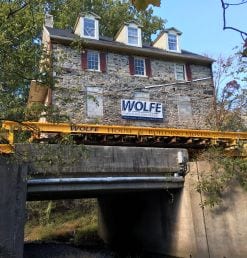How Much Does It Cost To Move a Building?
We explain the factors that affect the cost to move a house or building.
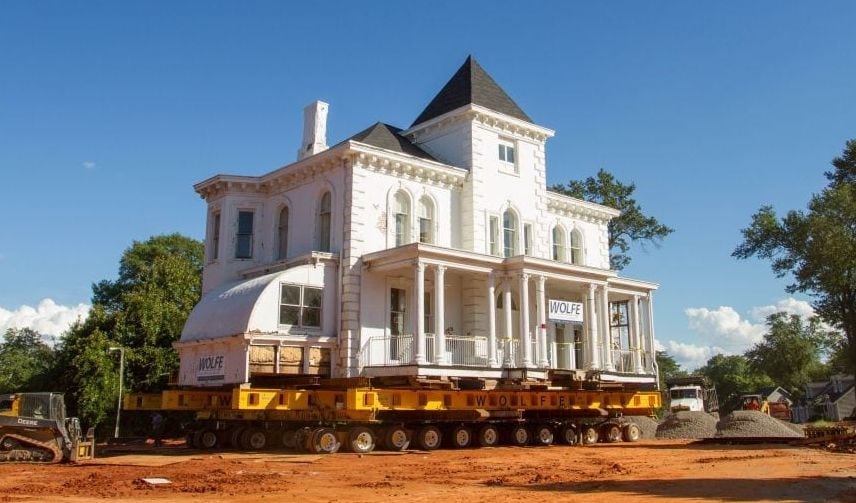 This 765-ton, historic brick mansion was moved 1/4 mile to a new location to save it from demolition.
This 765-ton, historic brick mansion was moved 1/4 mile to a new location to save it from demolition.
“How much will it cost to move my house (or building)?”
This is the most common question we’re asked, and it’s also the most difficult to answer. Unfortunately, the answer is not as straightforward as the question.
Factors such as size, weight, accessibility, move distance, and other obstacles (e.g., power lines, accessibility, structural integrity) all factor into the cost to move a home or building.
A good starting point is to complete our cost estimate survey, which will provide us with basic details about your project so that we can give you a ballpark cost.
Here are a few of the most common factors that directly affect the work and, therefore, the pricing of a structural move project.
Factor 1.
Size, Shape, and Type of Structure
Size. Obviously, the size of the structure matters. The amount of time needed to move an 800-square-foot cottage is very different than a 5,000-square-foot house. Knowing the square footage and/or the length and width of the building is one of the key factors in estimating a price.
Shape. Different shapes can affect pricing as well — a 3,000-square-foot, rectangular, 2-story house takes less time to move than a sprawling 3,000-square-foot, single-story house that is long and has wings at odd angles. The type of structure is important as well.
Structure Type. There are many types of structures: frame, frame with masonry veneer, log, double brick, triple brick, block, terra-cotta tile, concrete, stone, steel, post, etc. Any building can be moved, but each type has its unique aspects that factor into the cost.
Factor 2.
Type and Height of Foundation
Structural foundations vary as well. CMU block or poured concrete are the new standards for structural foundation.
Older homes often sit on a stone or rubble foundation. Wood pilings and piers are common under beach or shoreline homes. Homes in the southeastern region are usually built on brick piers or concrete slab floors.
The crawl space or basement height also is important since that is the area where we install the steel beam platform that carries the house. If the height under the first-floor system is fewer than 3 feet, it can add significant time to the project to excavate the dirt necessary to install the lifting steel. Tall crawl spaces and full basements are the easiest to work with, but all scenarios are possible.
When a house is built directly on a concrete slab floor, we can either install our steel through the walls to attach to the walls and lift the house up off of the slab, or we can lift and move the entire slab floor with the house (Note: This is very expensive and usually only worthwhile if the house is finished with high-end flooring, cabinets, and wall coverings).
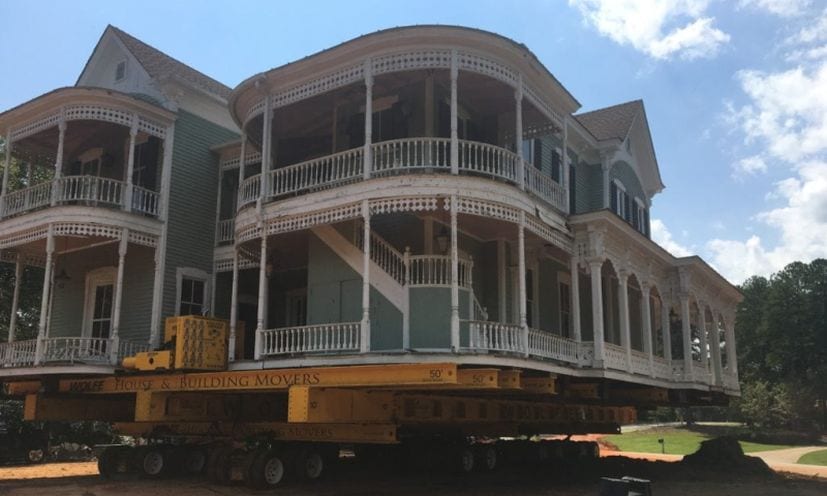
Factor 3.
Accessories
Garages, additions, porches, decks, balconies, chimneys, fireplaces, and other accessories can almost always be moved with the house, but add time and increase the project cost. In most cases, if the building can be moved with the accessories intact, it is cheaper to do so than to remove and rebuild.
However, if the accessories are intended to be demolished in the end anyway, then you will save money by doing so before the move.
Factor 4.
Working Space
Time is money.
Inadequate working space around the house can significantly extend the amount of time a job takes and therefore the price of the lift and move. If our crew does not have sufficient room to get our standard equipment around and under the house, then we may have to use smaller equipment that can be installed by hand or with smaller machines. This does not prevent us from moving the building but can affect the overall cost.
Factor 5.
New Foundation
There are several methods for installing a new foundation. The most common way is to have only the footers poured ahead of time. This allows the house to be driven down a ramp and over the footers. Then the house will be lifted up and supported while the new foundation is built up under it. If there is no room for a ramp, another option is to have the new foundation installed before the house arrives and then the house can be moved up to and slid on top of that foundation. This tends to be more expensive but is useful when necessary.
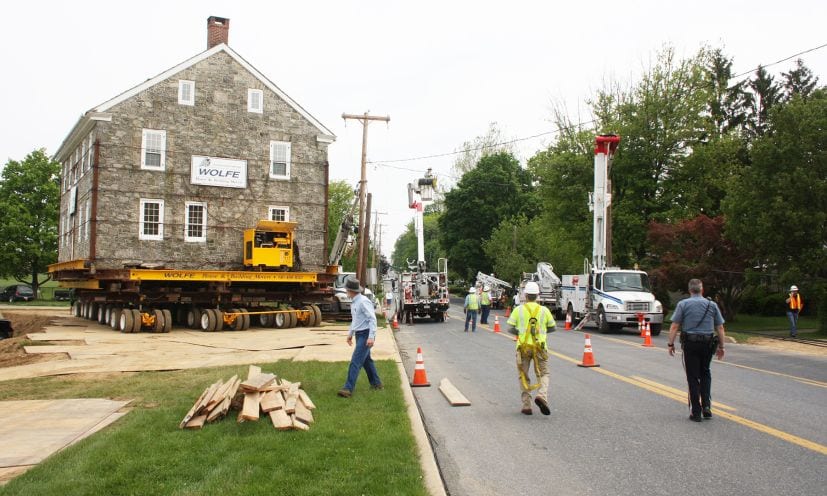
Additional Work To Consider
The following items are the responsibility of you and your general contractor, and will also affect the overall cost of the project.
-
Initial Planning and Permits
Architectural and structural drawings and permits are required in most areas to install a new foundation under a house.
-
Preparing the House
The utilities must be shut off and disconnected from the house, including electric, water, sewer, gas (must be shut off and cut off at the street), telephone, cable, etc. All pipes, plumbing, and ductwork in the crawl space or basement must be removed from beneath the floor joists. The exterior steps, skirting, shrubbery, outdoor showers, fences, and any accessories that are not being moved must be demolished and removed ahead of time.
-
Move Route
Clearing a move route is a very large price factor. Onsite moves are generally not a problem,
although excavation can be required in some cases; however, once you start heading down a road, there can be multiple obstacles.Tree branches were cut back to make room for this house move.
Is the house wider than the road? If the house overhangs the road, you will likely have trees, telephone poles, bridge railings, and possibly other buildings to contend with. If the width is clear, then you determine if any overhead obstacles might cause interference.
Overhead utility lines and other overhead structures often are obstacles, even for a single-story home move. The cost of lifting utility lines alone keeps most moves limited to a mile or two on the East Coast and the Midwest. Areas in the Central U.S., such as Texas and Oklahoma, generally have more width and height clearance before obstacles become an issue.
Tree trimming, traffic signals, sign and light posts, and traffic control are the other obstacles that must be looked into for feasibility and cost.
-
Excavation and New Foundation
The new foundation will need to be excavated and the foundation installed at the new site. Most houses will require a minimum of a 4’ crawlspace, and some masonry houses could require a full basement. In most cases, beam pockets are required for the top of the new foundation to give our lifting steel a place to recede into as the house is set down.
Final Steps
Once the foundation is built up, our crew will return to the site and remove our equipment. At that time, the foundation can be finished, waterproofed, and back-filled. Some framing will be necessary for new decks and steps. Utilities will need to be reinstalled and hooked up under the house, and then final landscaping can be done.
How To Get a Cost Estimate for Moving a House
These are some of the basic things can affect the overall cost and that you should be aware of before beginning the project.
We do not necessarily need all of this information to be able to provide you with a ballpark cost for the lift-and-move part of your project, but the more information you are able to provide, the more accurate we are able to be with your ballpark number.
Once you have a rough idea of the move cost from us, the cost of supporting trades from your general contractor, and you’ve decided to move ahead, we will send an estimator to your job site to review the project details with you. At that time, we will provide a written proposal for the work.
Request a Project Estimate
We don’t expect you to know the answers to all of the questions. Give us the information you do have, and we will see if that is enough to give you a ballpark cost.
You can download a paper form here or click the button below to submit the form electronically.

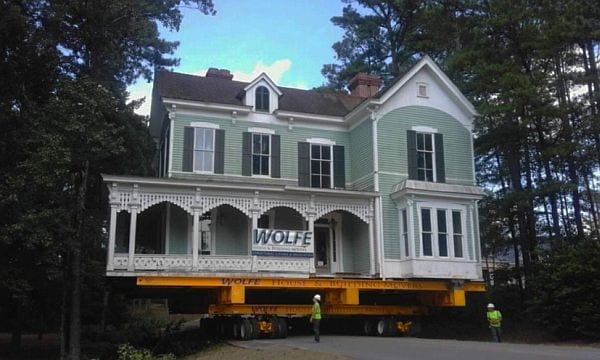 Tree branches were cut back to make room for this house move.
Tree branches were cut back to make room for this house move.